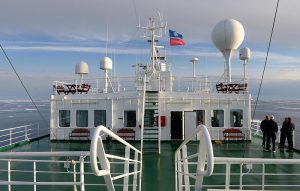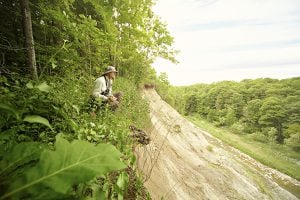
History
2014 Victoria Strait Expedition
This year's search is about much more than underwater archaeology. The Victoria Strait Expedition will contribute to northern science and communities.
- 1205 words
- 5 minutes
This article is over 5 years old and may contain outdated information.
History

“What you see underwater is often an extension of what you see on land,” says Parks Canada underwater archaeologist Ryan Harris. “The land in the Queen Maud Gulf area is low rising, and here we see a lot of glacial relics with moraine features. Eskers and drumlins can pop up unexpectedly.”
Charts of the Queen Maud Gulf — and much of the Arctic Archipelago — date largely from the 1950s. They paint a picture of the sea floor that is incomplete and frequently inaccurate. The Canadian Hydrographic Service, a branch of Fisheries and Oceans Canada, works in the region each summer to improve knowledge of the North’s navigability for Canadians, but it’s a huge area, and much of it is still effectively uncharted water.
When the depth finder on the Martin Bergmann hits 10 metres, the captain must turn the boat toward deeper water. When it’s 15 metres or less, the team can’t use its side-scan sonar because the Bergmann’s engine agitates the water and distorts the image that Parks Canada’s side-scan sonar returns. This compromises the data, which in turn means the team doesn’t know with any certainty what’s on the sea floor of the surveyed area.
This year, Parks Canada has added a Zodiac to its search arsenal. It’s a rigid-hulled inflatable boat that will help them take their search to shallower waters, where there could be a higher probability of finding the remains of Erebus or Terror.
“It’s a boat that we’ll be able to take our gear out of and leave up here over the winter, which will help us on subsequent searches,” Harris says.
On a mission that takes place in remote waters, hundreds of kilometres from port, it also improves safety. It’s common for several days to go by without seeing another boat. “We’re all alone out there on the Bergmann,” adds Harris, “and with this second platform, we’ll be able to deploy these smaller boats closer to shore. It’s a wiser choice in our search.”
The smaller boat will also help Harris get Parks Canada’s autonomous underwater vehicle (AUV) into areas that even small boats have difficulty reaching. “With the AUV, we’re able to look in relatively shallow waters,” he says. “We’ll be able to get closer to islands and closer to the Adelaide Peninsula on the mainland.”
The new equipment will allow for a more varied approach to the search for Erebus and Terror, affording access to waters that are remote and challenging. “You can only change gears,” Harris says, “if you brought the gear with you.”
Are you passionate about Canadian geography?
You can support Canadian Geographic in 3 ways:

History
This year's search is about much more than underwater archaeology. The Victoria Strait Expedition will contribute to northern science and communities.

Places
In Banff National Park, Alberta, as in protected areas across the country, managers find it difficult to balance the desire of people to experience wilderness with an imperative to conserve it

History
First official day of the 2014 search for Sir John Franklin’s lost ships

Places
It’s an ambitious plan: take the traditional Parks Canada wilderness concept and plunk it in the country’s largest city. But can Toronto’s Rouge National Urban Park help balance city life with wildlife?